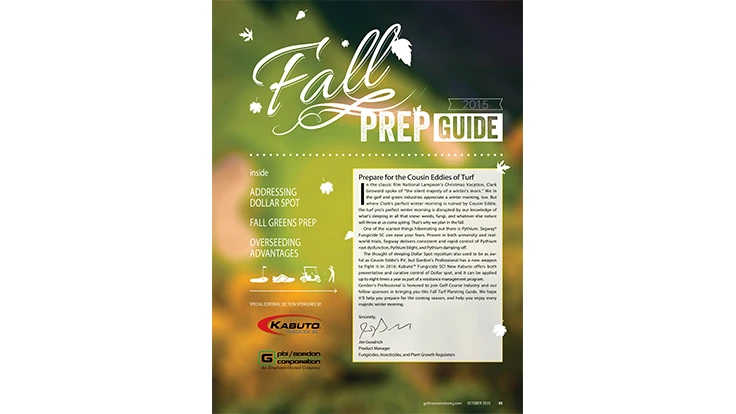
 Dollar spot affects an abundance of grasses common to golf courses, including annual and Kentucky bluegrass, bentgrass, Bermudagrass, fine and tall fescue ,and zoysiagrass. It thrives in climates that are warm (temperatures between 55 and 90 degrees Fahrenheit) and moist. Morning dew stimulates the spread of the fungus.
Dollar spot affects an abundance of grasses common to golf courses, including annual and Kentucky bluegrass, bentgrass, Bermudagrass, fine and tall fescue ,and zoysiagrass. It thrives in climates that are warm (temperatures between 55 and 90 degrees Fahrenheit) and moist. Morning dew stimulates the spread of the fungus.
The disease generally does not wreak the structural devastation on a plant that some other turf diseases do. Its impact is largely aesthetic. But aesthetic issues cost golf facilities significant dollars each year and superintendents are as passionate about combating it as they are about dealing with other turf issues.
Some superintendents report relatively few dollar-spot related problems. Chris Tritabaugh is in charge of the turf at Hazeltine National Golf Club in Chaska, Minn., southwest of Minneapolis, where he is in the midst of preparations for the 2016 Ryder Cup. As he prepares to host one of golf’s most significant events, he has an abundance of issues on his plate, great and small, but dollar spot is rarely one of them.
Tritabaugh, though, notes other facilities in the Twin Cities area weren’t so fortunate this summer. “In August and September we had some massive dollar-spot pressure,” he says. “Places around the Twin Cities were fighting it left and right. It was perfect weather for it, but we didn’t have any and I had no fungicide down. Maybe [the golf course] could get it if you put it in the Transition Zone, but up here you get a little bit of a breeze.”
A key to keeping dollar spot at bay is keeping dew off the fairways. “We drag the dew first thing every morning,” he says.
Tritabaugh does have to take care with his tees, some of which consist of older grasses and thus are more susceptible to dollar spot.
“Some of our tees have older grasses, but as they’ve been rebuilt or reconfigured over the years they’ve been regrassed with different things,” he says. “Our tees do get some of it, even tees with the newer grasses. I really believe you take the newer greases that have resistance to dollar spot, then you get that dew off first thing in the morning, that’s just about all that they need, at least in our climate.”
When it comes to chemical control Tritabaugh emphasizes that he tries to use as little fungicide or other chemical compounds as possible regardless of the issue he’s dealing with.
“The new products the companies are coming out with now are really [designed for] low usage rates, which is great,” he says. “You’re using very little actual chemical. They’re taking care of the disease in a contact type of manner which is going to keep the resistance low or not allow resistance at all.”
Tritabaugh will readily admit that the climate in the Upper Midwest has been an asset in his efforts to keep dollar spot at bay. Other superintendents don’t have that advantage.
Eric Nelson is the superintendent at the 1757 Golf Club in Sterling, Virginia, not far from Washington, D.C., and the Washington Redskins’ practice facility is just a short drive away. While the club offers memberships, it is essentially a daily-fee facility.
Nelson’s primary weapon against dollar spot is chlorothalonil. “There’s an old saying, ‘Paint it white, sleep well at night,’” he says. “When you apply this chemical, it goes on kind of white and it combats nine out of 10 pathogens.”
But efforts against dollar spot are complicated by the fact that over time the fungus develops resistance to the chemistries used to eradicate it. Chlorothalonil, as effective as it is, is highly unlikely to eradicate dollar spot on its own. Conventional wisdom stipulates that a superintendent have multiple weapons in his or her arsenal.
Jim Goodrich is the product manager for fungicides, insecticides and PGRs for PBI-Gordon in Kansas City. He spent five years as a superintendent early in his career. “One school of thought, and it’s become kind of antiquated, is that use one chemistry and continue to use that chemistry until it starts to fail on you. Then you switch,” he says. “That happened to me. I applied some product to some dollar spot that popped up and it just didn’t work … You always to have something else in your back pocket. The idea is to have a rotational partner. If you apply something for early season dollar spot control, your next application should usually be another chemistry.”
Nelson points out that over time turf diseases build up resistance to chemicals, just as illnesses afflicting humans become resistant to antibiotics over time.
“If you use [a chemical] constantly, funguses and bacteria adapt,” he says. “It’s why antibiotics become less effective. They change and you face that on a golf course. You face that with everything you do. A lot of companies say they have the cure-all, but the truth is, if you don’t constantly alter your chemistry, you’re going to have resistance issues.”
Nelson embraces the idea of having an abundance of resources at his disposal. His spraying program encompasses 16 applications over the course of 32 weeks. “I base the [spraying schedule) on a 32-week season where we’re susceptible to dollar spot,” he says. “[In the fall] the pressure has eased and I’ll go out and spray as needed. But in June July and August, I’ll spray every 14 days come hell or high water. Otherwise you leave yourself susceptible.”
Nelson typically alternates between chlorothalonil and some other compound. Over the course of his 32 week “spraying season,” he estimates he’ll use five different chemical combinations.
Jeff Marvin is PBI-Gordon’s manager of field research. He has nine years experience as a superintendent and has waged his own battles with dollar spot. He notes that his company is in the process of introducing a new dollar-spot product.
“PBI-Gordon is releasing Kabuto, a new SDHI fungicide for the control of dollar spot,” he says. “Kabuto is a newer generation SDHI that shows good resistance management for dollar spot.” But Marvin is quick to note that Kabuto is intended to be used in conjunction with other chemistries.
“We still require applicators to not apply more than two consecutive applications of Kabuto before switching to a different mode of action,” he adds. “Most universities have programs they recommend or guidance on the different modes of action for fungicides. With the addition of Kabuto and our current Product, Segway for pythium diseases, PBI-Gordon provides two very good options for two of the most damaging disease on turfgrass.”
Marvin stresses that Kabuto, like any product, must be used responsibly. “You cannot use Kabuto every single week throughout the course of the year and realistically expect not to see resistance,” he says. “That’s not responsible stewardship of a product, in my mind. We’re promoting Kabuto as a tool in the toolbox for dollar spot. It works extremely well, but it’s on a 14-day rotation, so after 14 days, you have to come in with another mode of action. If you want to go back to Kabuto, you’re more than welcome to [but] you’ve got to rotate your modes of action.”
Other key steps will help reduce the impact of dollar spot, including scheduling irrigation to minimize the effects of dew, which stimulates dollar spot growth. Irrigate at night or in early morning; avoid early-evening hours. It’s also important to infuse the soil with nitrogen to delay outbreaks in the spring and reduce the severity of those that do occur, according to Purdue University Extensive Service research.
Rick Woelfel is a Philadelphia-based writer and frequent GCI contributor.

Explore the October 2015 Issue
Check out more from this issue and find your next story to read.
Latest from Golf Course Industry
- From the publisher’s pen: Conscientious of a bigger role
- Bernhard and Company partners with Laguna Golf Phuket
- Terre Blanche showcases environmental stewardship
- VIDEO: Introducing our December issue
- Bernhard and Company introduces Soil Scout
- Nu-Pipe donates to GCSAA Foundation’s Centennial Campaign
- GCSAA enhances golf course BMP tool
- Melrose leadership programs sending 18 to 2026 GCSAA Conference and Trade Show





